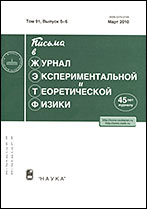|
|
Pis'ma v Zhurnal Èksperimental'noi i Teoreticheskoi Fiziki, 2004, Volume 79, Issue 5, Pages 280–285
(Mi jetpl2245)
|
 |
|
 |
This article is cited in 51 scientific papers (total in 51 papers)
CONDENSED MATTER
Thermally stable hydrogen compounds obtained under high pressure on the basis of carbon nanotubes and nanofibers
I. O. Bashkina, V. E. Antonova, A. V. Bazhenova, I. K. Bdikina, D. N. Borisenkoa, E. P. Krinichnayab, A. P. Moravskiib, A. I. Kharkunova, Yu. M. Shul'gab, Yu. A. Osip'yana, E. G. Ponyatovskiia
a Institute of Solid State Physics, Russian Academy of Sciences
b Institute of Problems of Chemical Physics, Russian Academy of Sciences, Chernogolovka, Moscow region
Abstract:
Compounds containing 6.3–6.5 wt % H and thermally stable in vacuum up to 500°C were obtained by annealing graphite nanofibers and single-walled carbon nanotubes in hydrogen atmosphere under a pressure of 9 GPa at temperatures up to 45°C. A change in the X-ray diffraction patterns indicates that the crystal lattice of graphite nanofibers swells upon hydrogenation and that the structure is recovered after the removal of hydrogen. It was established by IR spectroscopy that hydrogenation enhances light transmission by nanomaterials in the energy range studied (400–5000 cm−1) and results in the appearance of absorption bands at 2860–2920 cm−1 that are characteristic of the C–H stretching vibrations. The removal of about 40% of hydrogen absorbed under pressure fully suppresses the C–H vibrational peaks. The experimental results are evidence of two hydrogen states in the materials at room temperature; a noticeable portion of hydrogen forms C–H bonds, but the most of the hydrogen is situated between the graphene layers or inside the nanotubes.
Received: 03.02.2004
Citation:
I. O. Bashkin, V. E. Antonov, A. V. Bazhenov, I. K. Bdikin, D. N. Borisenko, E. P. Krinichnaya, A. P. Moravskii, A. I. Kharkunov, Yu. M. Shul'ga, Yu. A. Osip'yan, E. G. Ponyatovskii, “Thermally stable hydrogen compounds obtained under high pressure on the basis of carbon nanotubes and nanofibers”, Pis'ma v Zh. Èksper. Teoret. Fiz., 79:5 (2004), 280–285; JETP Letters, 79:5 (2004), 226–230
Linking options:
https://www.mathnet.ru/eng/jetpl2245 https://www.mathnet.ru/eng/jetpl/v79/i5/p280
|


| Statistics & downloads: |
| Abstract page: | 359 | | Full-text PDF : | 100 | | References: | 60 |
|





 Contact us:
Contact us: Terms of Use
Terms of Use
 Registration to the website
Registration to the website Logotypes
Logotypes









